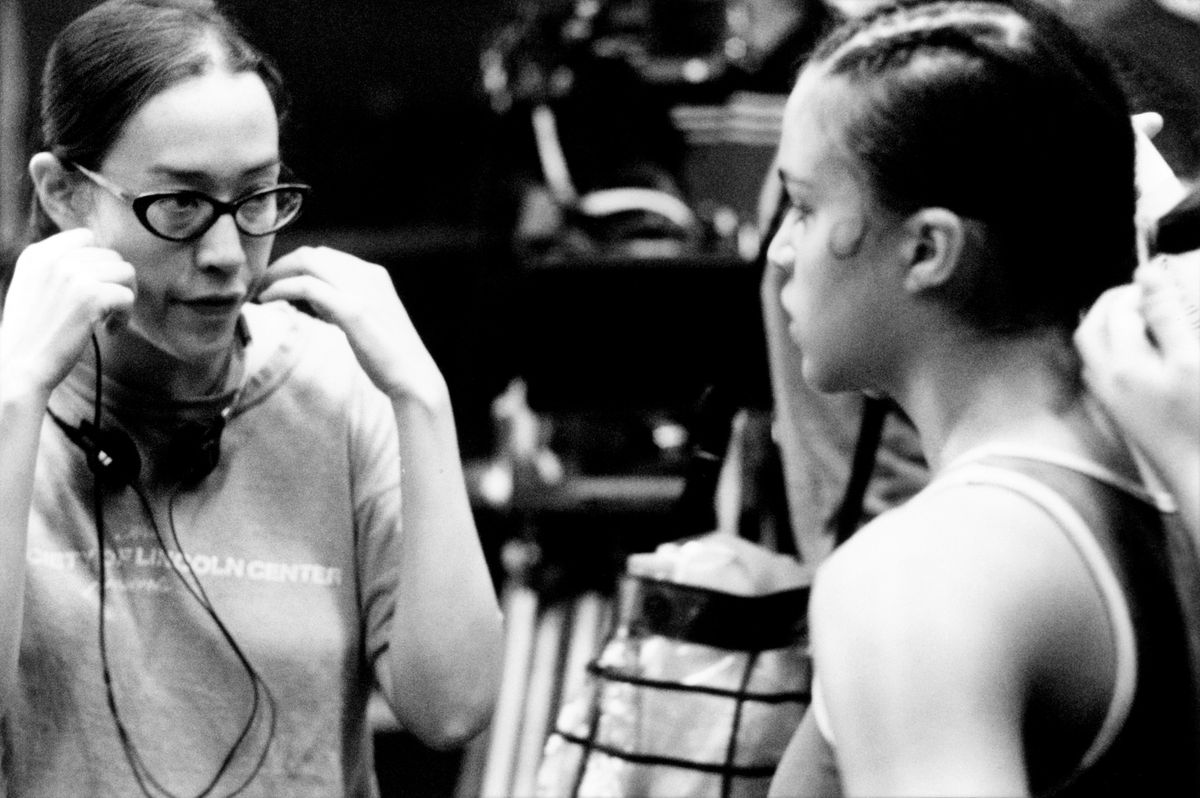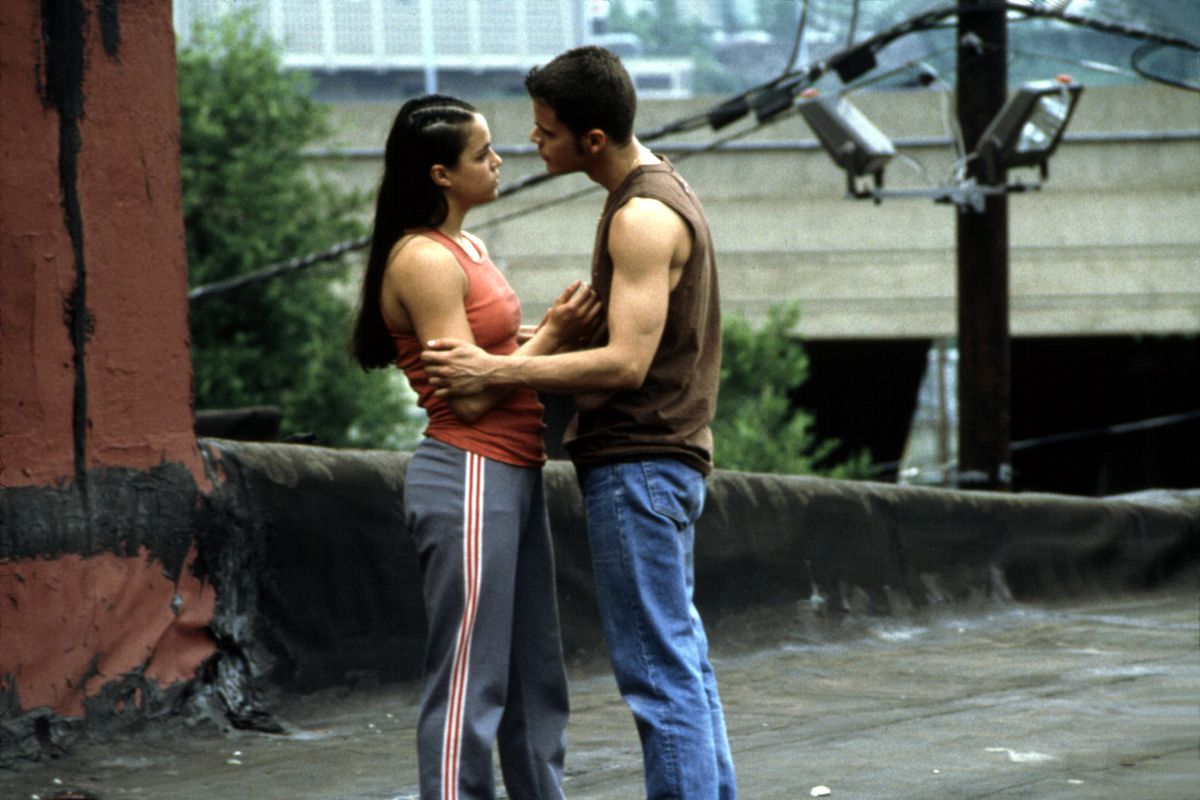Karyn Kusama on the ‘beautiful and painful’ process of rewatching Girlfight for Criterion
Not every filmmaker gets their feature film debut captured in the Criterion Collection. But not every feature debut from every filmmaker is equally impressive Girls fight do.
Decades after its release, Karyn Kusama’s debut film, Girls fightstill holds up today – it’s no surprise that it launched her career as a director of subversive horror drama (Jennifer’s body, The invitation) and memorable television (Yellow jackets, Stop and catch fire, The man in the high castle), along with the launch of Michelle Rodriguez as a star. Girls fight comes to the Criterion collection on May 28featuring a brand new 4K digital restoration overseen by Kusama, new interviews and commentary from the director, and a sleek new cover by Jillian Adel.
Girls fight, the story of a troubled high school student who secretly takes up boxing as an outlet for her frustrations, and struggles with high school emotions both inside and outside the boxing ring. At the same time, it subverts the tropes of boxing films. Rodriguez plays Diana Guzman, a teenager who often gets into trouble because she fights at school and is estranged from her father (Paul Calderón) at home. When she tries boxing in secret to get some of that tension off her chest, she shows a real talent for the sweet science. At the gym she meets a boy (named Adrian, making Diana the Rocky in this equation) and a new father figure in her trainer (Jaime Tirelli).
Image: Screen Gems/Everett Collection
To make Girls fight was a long process for Kusama, who wrote the film after taking up boxing herself in 1992. Production companies begged her to cast a white woman in the lead role, but she stuck to her guns, pushing for a Latina lead role and finding Rodriguez in an extended film. audition process that focuses largely on non-professional actors. After financiers pulled out two days before pre-production in 1999, legendary filmmaker (and Kusama’s former mentor) John Sayles and his creative partner and producer Maggie Renzi stepped in and helped finance the film.
Polygon spoke with Kusama during a video call ahead of Criterion’s release. We talked about rewatching her first film before the restoration, when she knew she had a star in Rodriguez, and or Girls fight could now be made in the same way.
Polygon: Congratulations Girls fight will be added to the Criterion Collection. When did you find out and what was your reaction?
Karyn Kusama: This must have been last year. Criterion contacted me and said, ‘We really want to remaster Girls fight and release an edition of the film.” I was floored and so excited. I’m such a Criterion nerd, as you might imagine, so it was literally a dream come true. To me, this just felt like the ultimate stamp of approval.
Does it mean more to you because it was this one?
I think what I appreciate is that it’s my first film. And as someone who now has more than twenty years of time and experience to look back at the film, there are so many things I could do differently: I could improve, I could cut back, change or refine. And so the idea that it can still work for everyone, despite the fact that I would love to get back into it and completely redesign it, is satisfying.

Photo: Abt Genser/Screen Gems/Everett Collection
Watching it now, I was struck by the balance between the boxing elements, the family drama, the character study, Michelle Rodriguez’s stellar performance, and the high school romance. How do you think about the balance of all those elements?
I never felt like I wanted to make a purely boxing-oriented film. In some ways, the true story is about this character entering a new world and finding a place for himself in it. And in doing so, she opens herself up to a kind of vulnerability that she cannot expose at home. So much of it is about this tension between the closed emotional world of her family life and the more expansive emotional world of, paradoxically, a boxing ring. So that was something I knew I wanted to do. But I don’t know at the time if I was really considering the balance of it all.
In somewhat twisted terms, I tried to tell a story about a young woman for whom traditional expressions of femininity didn’t feel entirely true. And so it was mainly about finding a path to self-acceptance, to some kind of openness, to whatever kind of crazy she would eventually become.
Looking at the film now, what would you like to change?
I think I would probably lift some scenes and tighten some scenes. I think I would know a little more about how to evoke the same emotional impact with fewer cuts or fewer shots. I would just get to the heart of the matter more quickly. But that said, I think some of what I struggle with in the film is also inherent in it, you know, which is a lot of non-actors, a lot of young, raw performances. And in some ways, I hope, that’s part of the film’s charm.
And it helps that the central three of her family are so strong.
Oh good. Yeah I think so. Obviously, Paul Calderón (who played Marie’s father) was, and still is, a great and well-known actor at the time, and so he was able to anchor the rest of the cast a bit. But you know, it’s funny, I always find that with films for me it’s a process of making something, hoping that I make the truest thing I can make, and then moving on and not looking back. And what’s really weird about doing the Criterion Edition is: the process of rewatching is both beautiful and painful. I watched the movie a lot. So it gave me a lot of time to think, Oh, I could have done that too. I should have done that. Lots of woulds, woulds, shoulds.

Image: Screen Gems/Everett Collection
Do you think things have changed in the industry over the last twenty years? Would make Girls fight be the same, easier or more difficult?
That’s something I have to chew on. Because in some ways, of course, we all want the answer to be, “Things are better now.” I think the harsh reality is that we are still almost even more entrenched in a star-driven system. So it would be even harder now, I think, to make a movie with a completely new face at the center of the movie.
And luckily for me, when I made it Girls fight, Michelle eventually gained a real electric, charismatic star power that allowed her to continue making films. But now I notice that it is still very difficult. As for the questions around representation? I think the conversations are more consciously coded around what is allowed. But I think ultimately there is still a lot of resistance to a convoluted or complex representation of the world as we actually live it.
What did you learn from working with Michelle Rodriguez on the film about what makes a movie star and how to showcase that?
Oh, that’s such a good question. I mean, first of all, she has a funny lack of self-awareness as an actor. During the initial audition process, and initially when I was working with her, I kind of had to remind her to stay in character, to stick to the book and all the basics of being an actor. What she didn’t have was shame. There was a quality to her of something like: I’m here. The world can begin now. And that quality of guileless trust is really important. She demanded attention.
And that simple kind of intensity is something that I’ve really learned is actually not common everywhere. It’s not like every actor I work with has the same intensity, although I’ve certainly worked with actors who had more training, more experience, and more discipline. Michelle has some kind of ineffable charisma.
Was there a specific moment with her where you thought: Oh, she’s differentor is that just something you learned while filming?
It’s really funny because I have such a vivid memory of doing all those first auditions and having hundreds of people in front of us for interviews and short auditions. And we recorded them all. And since I’m a little obsessed with thoroughness, I decided to just go through the process of watching all the tapes.
And it was at that moment that I watched her tape, even though she was untrained, completely inexperienced, completely unprepared, and from every negative point you can think of, she held the screen so completely that I felt like: Hey, that’s interesting. I have to keep looking at her, I have to keep engaging with this presence. And so it just meant that we kept bringing her back. But that first feeling about her was definitely something that I look at now and realize: Oh, that was her. That was her star power.

Image: Screen Gems/Everett Collection
Did you predict she would star in major franchises like Fast and the Furious?
At the time I couldn’t, but she called it out for herself much sooner than I could have. Because she always knew what she liked. Right when she read The fast and the furiousshe was like, I know I have to do this, and I know it will be a global franchise. She understood that part of entertainment much better than I did.
Have there been opportunities to work with her on projects of that scale? Is that something you’re interested in?
You mean like the giant franchises?
Yes. Doesn’t seem like your vibe at all, but you never know.
No, it’s not really my feeling. And a lot of that just has to do with the idea that you have to create something that is part of a very large entity with a lot of history, and a lot of relationships that people already bring to the characters, in the world’s. For that reason, I’m not sure I would be the best candidate for that type of work, but never say never, I guess.
You are in a very interesting space with both TV and movie options. What is your next focus and where do you see yourself moving towards?
I have to make personal films again. That’s where I really learn and bend and experiment and fail and try and everything, you know. So that’s next for me: figuring out what the next feature will be.
